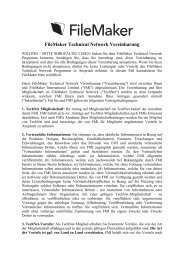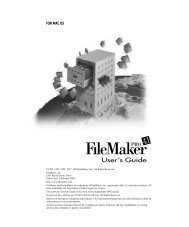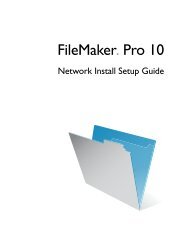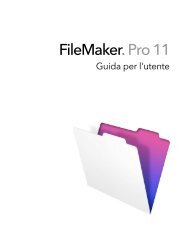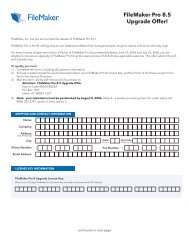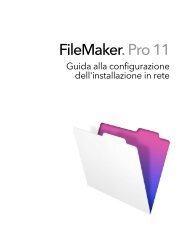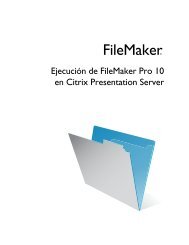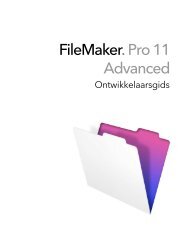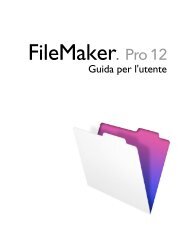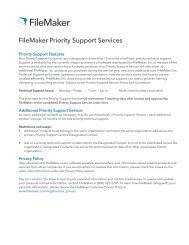FileMaker Pro 5 Manuel de l'utilisateur
FileMaker Pro 5 Manuel de l'utilisateur
FileMaker Pro 5 Manuel de l'utilisateur
You also want an ePaper? Increase the reach of your titles
YUMPU automatically turns print PDFs into web optimized ePapers that Google loves.
Chapitre 12<br />
Importation et exportation <strong>de</strong>s données<br />
Vous avez la possibilité d’échanger <strong>de</strong>s informations avec <strong>de</strong>s<br />
fichiers <strong>FileMaker</strong> <strong>Pro</strong> ou <strong>de</strong> fichiers créés à partir d’autres<br />
applications. Le présent chapitre explique comment :<br />
1 Importer <strong>de</strong>s données dans un fichier ;<br />
1 Remplacer les fiches d’un fichier par celles d’un autre fichier ;<br />
1 Mettre à jour les fiches d’un fichier en fonction <strong>de</strong> celles d’un autre<br />
fichier ;<br />
1 Convertir en fichiers <strong>FileMaker</strong> <strong>Pro</strong> <strong>de</strong>s documents créés à partir<br />
d’autres applications ;<br />
1 Exporter <strong>de</strong>s données à utiliser avec d’autres applications.<br />
Pour échanger <strong>de</strong>s données par ODBC, reportez-vous au<br />
Chapitre 15, Utilisation du pilote ODBC avec <strong>FileMaker</strong> <strong>Pro</strong>.<br />
Pour utiliser la fonctionnalité OLE (Object Linking and Embedding,<br />
liaison et incorporation d’objets), choisissez le menu Ai<strong>de</strong> ><br />
Sommaire et in<strong>de</strong>x, cliquez sur l’onglet In<strong>de</strong>x et entrez OLE.<br />
Pour transférer <strong>de</strong>s scripts d’un fichier <strong>FileMaker</strong> <strong>Pro</strong> à un autre,<br />
reportez-vous à la section Importation d’un script, page 10-12.<br />
Pour copier la définition <strong>de</strong>s rubriques dans un fichier vi<strong>de</strong>,<br />
enregistrez un clone du fichier. Reportez-vous à la section<br />
Enregistrement <strong>de</strong> fichiers, page 1-8.<br />
A propos <strong>de</strong> l’importation et <strong>de</strong><br />
l’exportation<br />
<strong>FileMaker</strong> <strong>Pro</strong> permet <strong>de</strong> :<br />
1 <strong>Pro</strong>cé<strong>de</strong>r à <strong>de</strong>s importations : importer <strong>de</strong>s données d’un fichier<br />
<strong>FileMaker</strong> <strong>Pro</strong> dans un autre fichier ;<br />
1 <strong>Pro</strong>cé<strong>de</strong>r à <strong>de</strong>s exportations : enregistrer <strong>de</strong>s données<br />
<strong>FileMaker</strong> <strong>Pro</strong> à utiliser dans une autre application.<br />
Remarque Aucune importation ou exportation n’est nécessaire pour<br />
transférer <strong>de</strong>s données entre une machine Windows et un ordinateur<br />
Mac OS. Ouvrez les fichiers comme vous en avez normalement<br />
l’habitu<strong>de</strong>. Reportez-vous à la section Ouverture <strong>de</strong> fichiers,<br />
page 1-7.<br />
Points importants à noter :<br />
1 Vous pouvez échanger <strong>de</strong>s données avec <strong>de</strong>s fichiers<br />
<strong>FileMaker</strong> <strong>Pro</strong> partagés. Pour accé<strong>de</strong>r à ce type <strong>de</strong> fichier, reportezvous<br />
à la section Ouverture <strong>de</strong> fichiers en tant qu’invité, page 13-5.<br />
1 Pour échanger <strong>de</strong>s volumes <strong>de</strong> données peu importants entre les<br />
fichiers (par exemple, quelques fiches), utilisez la fonction Copier et<br />
Coller, ou glisser-déposer. Reportez-vous à la section Saisie <strong>de</strong><br />
données dans les fiches, page 2-7.<br />
1 Lorsque vous échangez <strong>de</strong>s informations entre <strong>de</strong>s fichiers<br />
<strong>FileMaker</strong> <strong>Pro</strong> localisés sur un ordinateur Windows et un Macintosh,<br />
il se peut que certaines différences apparaissent au niveau <strong>de</strong>s noms<br />
<strong>de</strong> fichiers et <strong>de</strong> la substitution <strong>de</strong> jeux <strong>de</strong> caractères.<br />
1 La plupart <strong>de</strong>s formats <strong>de</strong> fichier ne prennent pas en charge<br />
l’importation ni l’exportation <strong>de</strong>s attributs <strong>de</strong> texte (police, taille,<br />
style ou couleur).



